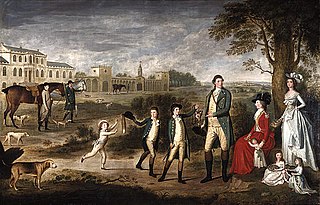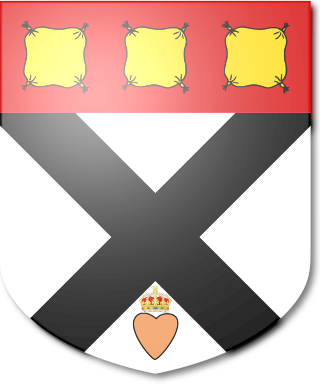Related Research Articles
There have been ten baronetcies created for persons with the surname Browne, six in the Baronetage of Great Britain, three in the Baronetage of Ireland and one in the Baronetage of Nova Scotia. Only one creation is extant as of 2010. Three of the creations were for members of the Browne family headed by the Viscount Montagu.

There have been five baronetcies of the United Kingdom created for a person with the surname Erskine, two in the Baronetage of Nova Scotia, one in the Baronetage of Great Britain and two in the Baronetage of the United Kingdom. Two of the creations are extant as of 2010.
There have been four baronetcies for persons with the surname Blake, one in the Baronetage of Ireland, two in the Baronetage of Great Britain and one in the Baronetage of the United Kingdom. Two of the creations are extant as of 2010. The Blake Baronetcy, of Menlough in the County of Galway, was created in the Baronetage of Ireland on 10 July 1622 for Valentine Blake, Mayor of Galway in 1611 and 1630 and a member of the Irish House of Commons for County Galway. His grandfather Thomas Blake had preceded him as Mayor. The second Baronet was a member of the Irish Parliament for Galway Borough. The third Baronet represented both County Galway and Galway Borough in Parliament. The sixth Baronet was a member of the Irish House of Commons for County Galway. He was the first Catholic gentlemen of distinction to join William of Orange. The twelfth Baronet represented Galway Borough in the British House of Commons. The fourteenth Baronet was high sheriff of County Galway in 1872. See also the Blake Baronetcy of Twizell Castle below.

The Johnstone, later Pulteney, later Johnstone Baronetcy, of Westerhall in the County of Dumfries, is a title in the Baronetage of Nova Scotia. It was created on 25 April 1700 for John Johnstone, one of the Scottish representatives to the 1st Parliament of Great Britain, with remainder to his heirs male. He was eighth in descent from Matthew Johnstone, who is said to have been a younger son of Sir Adam Johnstone, ancestor of the Earls and Marquesses of Annandale. The second Baronet sat as a Member of Parliament for Dumfries and Dumfriesshire. The third Baronet represented Dumfries, while the fourth Baronet sat as Member of Parliament for Dumfries and Weymouth. The fifth Baronet, Sir William, was Member of Parliament for Cromarty and Shrewsbury. He married Frances, daughter of Daniel Pulteney and niece and heiress of William Pulteney, 1st Earl of Bath, through which marriage vast estates came into the family. On his marriage Sir William assumed the surname of Pulteney in lieu of Johnstone. His only child, Laura, inherited the Pulteney estates and was created Countess of Bath in 1803. The sixth, seventh and eighth Baronets all represented Weymouth in Parliament. The sixth Baronet twice declined a peerage offered to him by Spencer Perceval.

There have been twenty one baronetcies created for persons with the surname Williams, eight in the Baronetage of England, three in the Baronetage of Great Britain and ten in the Baronetage of the United Kingdom. Only six of the creations are extant as of 2017.

The Gibson, later Gibson-Carmichael, later Gibson-Craig-Carmichael Baronetcy, of Keirhill in the County of Edinburgh, is a title in the Baronetage of Nova Scotia. It was created on 31 December 1702 for Thomas Gibson, with remainder to his heirs male. The sixth Baronet assumed the additional surname of Carmichael. The eleventh Baronet was a Liberal politician. In 1912, he created Baron Carmichael, of Skirling in the County of Peebles, in the Peerage of the United Kingdom. The barony died in 1926, while he was succeeded in the baronetcy by his kinsman Sir Henry Thomas Gibson-Craig-Carmichael, 5th Baronet, of Riccarton, who became the twelfth Baronet of Keirhill and assumed the additional surname of Carmichael.
There have been seven baronetcies created for persons with the surname Lawrence, one in the Baronetage of England, one in the Baronetage of Great Britain and five in the Baronetage of the United Kingdom.

The Hales Baronetcy, is a title in the Baronetage of England. There were three Hales baronetcies. The oldest was created in 1611 for Edward Hales. He was a member of a Kent family. The second was created in 1660 for Robert Hales, MP for Hythe 1659, also of a Kent family. The third was created in 1660 for John Hales of Coventry, co. Warwick.
There have been four baronetcies created for persons with the surname Preston, two in the Baronetage of Nova Scotia, one in the Baronetage of England and another in the Baronetage of the United Kingdom.
Lines of baronets bearing the surname Stirling have existed since the 17th century in several distinct localities of Scotland. The earlier baronetages were created within the Baronetage of Nova Scotia and those after 1707 within that of Great Britain (GB).
There have been three baronetcies created for people with the surname Riddell, one in the Baronetage of Nova Scotia, one in the Baronetage of Great Britain and one in the Baronetage of the United Kingdom. As of 2014 one creation is extant.
There have been two baronetcies created for persons with the surname Piers, one in the Baronetage of Nova Scotia and one in the Baronetage of Ireland. One creation is extant as of 2008 while the other is dormant.
There have been three baronetcies created for persons with the surname Dryden, one in the Baronetage of England and two in the Baronetage of Great Britain. Two of the creations are extant and are joined under a single holder since 1874.
There have been three baronetcies created in the Baronetage of England for members of the Skipwith family of Skipwith, Yorkshire, which relocated to Lincolnshire in the 14th century. They were a successful court family, with one member, Margaret Skipwith, seen as a possible queen of England after the death of Henry VIII's third wife, Jane Seymour. One creation of the baronetcy is extant as of 2008.

There have been three baronetcies created for persons with the surname Carew, two in the Baronetage of England prior to 1707, one in the Baronetage of Great Britain.
There have been three baronetcies created for persons with the surname Foulis, one in the Baronetage of England and two in the Baronetage of Nova Scotia.
There have been four baronetcies created for people with the surname Innes, three in the Baronetage of Nova Scotia and one in the Baronetage of the United Kingdom. Three of the creations are extant as of 2010.
There have been four baronetcies created for persons with the surname Hay, all in the Baronetage of Nova Scotia. Two creations are extinct, one dormant and one extant. A fifth baronetcy in the Jacobite Peerage, although theoretically extant, is not recognised by the Lyon Office.
There have been three baronetcies created for people with the surname Moncreiffe or Moncreiff, two in the Baronetage of Nova Scotia and one in the Baronetage of the United Kingdom. Two of the titles are dormant, as the heir has not proved his descent, and one is extant, though its holder does not bear the surname of Moncreiffe.

The Astley, later Astley-Corbett, later Astley Baronetcy, of Everley in the County of Wiltshire, was created in the Baronetage of the United Kingdom on 15 August 1821 for John Astley, Member of Parliament for Wiltshire and Wiltshire North. He was a descendant of Thomas Astley, younger brother of the first Baronet of Patshull. The third Baronet represented Lincolnshire North in Parliament as a Conservative. He married Eleanor Blanche Mary, daughter of Thomas George Corbett. Their eldest son, Francis, the fourth Baronet, assumed by Royal licence the additional surname of Corbett in 1890. His grandson, Francis, the fifth Baronet, was killed in action in World War II.